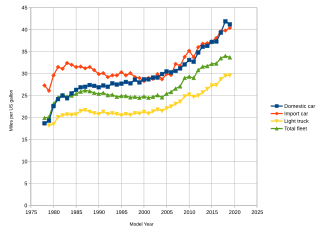Related Research Articles

A seat belt, also known as a safety belt or spelled seatbelt, is a vehicle safety device designed to secure the driver or a passenger of a vehicle against harmful movement that may result during a collision or a sudden stop. A seat belt reduces the likelihood of death or serious injury in a traffic collision by reducing the force of secondary impacts with interior strike hazards, by keeping occupants positioned correctly for maximum effectiveness of the airbag, and by preventing occupants being ejected from the vehicle in a crash or if the vehicle rolls over.

The Ford Pinto is a subcompact car that was manufactured and marketed by Ford Motor Company in North America from 1971 until 1980. The Pinto was the first subcompact vehicle produced by Ford in North America.

A crash test is a form of destructive testing usually performed in order to ensure safe design standards in crashworthiness and crash compatibility for various modes of transportation or related systems and components.

Unsafe at Any Speed: The Designed-In Dangers of the American Automobile is a non-fiction book by consumer advocate Ralph Nader, first published in 1965. Its central theme is that car manufacturers resisted the introduction of safety features, and that they were generally reluctant to spend money on improving safety. The work contains substantial references and material from industry insiders. It was a best seller in non-fiction in 1966.

Automotive safety is the study and practice of automotive design, construction, equipment and regulation to minimize the occurrence and consequences of traffic collisions involving motor vehicles. Road traffic safety more broadly includes roadway design.

Corporate average fuel economy (CAFE) standards are regulations in the United States, first enacted by the United States Congress in 1975, after the 1973–74 Arab Oil Embargo, to improve the average fuel economy of cars and light trucks produced for sale in the United States. More recently, efficiency standards were developed and implemented for heavy-duty pickup trucks and commercial medium-duty and heavy-duty vehicles.

A bumper is a structure attached to or integrated with the front and rear ends of a motor vehicle, to absorb impact in a minor collision, ideally minimizing repair costs. Stiff metal bumpers appeared on automobiles as early as 1904 that had a mainly ornamental function. Numerous developments, improvements in materials and technologies, as well as greater focus on functionality for protecting vehicle components and improving safety have changed bumpers over the years. Bumpers ideally minimize height mismatches between vehicles and protect pedestrians from injury. Regulatory measures have been enacted to reduce vehicle repair costs and, more recently, impact on pedestrians.

A car seat is the seat used in automobiles. Most car seats are made from inexpensive but durable material in order to withstand prolonged use. The most common material is polyester.
The National Highway Traffic Safety Administration is an agency of the U.S. federal government, part of the Department of Transportation, focused on transportation safety in the United States.

The National Traffic and Motor Vehicle Safety Act was enacted in the United States in 1966 to empower the federal government to set and administer new safety standards for motor vehicles and road traffic safety. The Act was the first mandatory federal safety standards for motor vehicles. The Act created the National Highway Safety Bureau. The Act was one of a number of initiatives by the government in response to increasing number of cars and associated fatalities and injuries on the road following a period when the number of people killed on the road had increased 6-fold and the number of vehicles was up 11-fold since 1925. The reduction of the rate of death attributable to motor-vehicle crashes in the United States represents the successful public health response to a great technologic advance of the 20th century—the motorization of the United States.

The Center for Auto Safety is a Washington, D.C.-based 501(c)(3) consumer advocacy non-profit group focused on the United States automotive industry. Founded in 1970 by Consumers Union and Ralph Nader, the group focuses its efforts on enacting reform though public advocacy and pressuring the National Highway Traffic Safety Administration and automakers through litigation. For decades, it was led by Executive Director Clarence Ditlow, who died in late 2016 from cancer. Ditlow was widely admired in the auto safety community, although he also had detractors among auto manufacturers. The Center for Auto Safety is currently led by Executive Director Jason Levine.

The National Maximum Speed Limit (NMSL) was a provision of the federal government of the United States 1974 Emergency Highway Energy Conservation Act that effectively prohibited speed limits higher than 55 miles per hour (89 km/h). The limit was increased to 65 miles per hour (105 km/h) in 1987. It was drafted in response to oil price spikes and supply disruptions during the 1973 oil crisis. Even after fuel costs began to decrease over time the law would remain in place until 1995 as proponents claimed it reduced traffic fatalities.
Injury prevention is an effort to prevent or reduce the severity of bodily injuries caused by external mechanisms, such as accidents, before they occur. Injury prevention is a component of safety and public health, and its goal is to improve the health of the population by preventing injuries and hence improving quality of life. Among laypersons, the term "accidental injury" is often used. However, "accidental" implies the causes of injuries are random in nature. Researchers prefer the term "unintentional injury" to refer to injuries that are nonvolitional but often preventable. Data from the U.S. Centers for Disease Control show that unintentional injuries are a significant public health concern: they are by far the leading cause of death from ages 1 through 44. During these years, unintentional injuries account for more deaths than the next three leading causes of death combined. Unintentional injuries also account for the top ten sources of nonfatal emergency room visits for persons up to age 9 and nine of the top ten sources of nonfatal emergency room visits for persons over the age of 9.
When a person makes a claim for personal injury damages that have resulted from the presence of a defective automobile or component of an automobile, that person asserts a product liability claim. That claim may be against the automobile's manufacturer, the manufacturer of a component part or system, or both, as well as potentially being raised against companies that distributed, sold or installed the part or system that is alleged to be defective.

Takata Corporation was a Japanese automotive parts company. The company had production facilities on four continents, with its European headquarters located in Germany. In 2013, a series of deaths and injuries associated with defective Takata airbag inflators made in their Mexico plant led Takata to initially recall 3.6 million cars equipped with such airbags. Further fatalities caused by the airbags have led the National Highway Traffic Safety Administration (NHTSA) to order an ongoing, US-wide recall of more than 42 million cars, the largest automotive recall in U.S. history. In June 2017, Takata filed for bankruptcy. It was acquired by Key Safety Systems. As of January 2024, over 100 million airbag inflators worldwide have been recalled by more than 20 carmakers.
Williamson v. Mazda Motor of America, Inc., 562 U.S. 323 (2011), was a decision by the Supreme Court of the United States, in which the Court unanimously held that Federal Motor Vehicle Safety Standard 208, promulgated by the National Highway Traffic Safety Administration, does not federally preempt state tort lawsuits against auto manufacturers from injuries caused by a defective lack of certain types of seat belts.
Motor Vehicle Manufacturers Association v. State Farm Mutual Automobile Insurance Co., 463 U.S. 29 (1983), is a United States Supreme Court decision concerning regulations requiring passive restraints in cars. In it, the Court struck down an order by the National Highway Traffic Safety Administration rescinding regulations that required either airbags or automatic seat belts in new cars.

Mark Rosekind served as the 15th Administrator of the National Highway Traffic Safety Administration (NHTSA). He was appointed by President Obama and sworn in in December 2014, replacing David L. Strickland who resigned in January 2014. NHTSA was run by David J. Friedman, the deputy administrator, in the intervening time.
Clarence Mintzer Ditlow III was an American consumer advocate, primarily focusing on automotive safety. He was closely associated with Ralph Nader's organizations, and has been given credit for helping to instigate several critical safety changes within the auto industry.

Heidi R. King served as acting Administrator of the National Highway Traffic Safety Administration.
References
- ↑ Snyder, Jim (December, 2008). Claybrook steps down at Public Citizen group. Archived 2008-12-12 at the Wayback Machine The Hill
- ↑ Roosevelt, Margot (August 8, 2006). Q & A: Joan Claybrook. Time
- 1 2 Holsendolph, Ernest (March 19, 1977). "Lobbyist for Nader to Head Safety Unit". The New York Times.
- ↑ Krisher, Tom, Speedometer top speed often exceeds reality , AP News, 28 February 2013, retrieved 7 August 2022
- ↑ "Interviews - Joan Claybrook | Rollover | FRONTLINE | PBS". pbs.org. February 21, 2002. Retrieved 3 June 2013.
- ↑ "Public Citizen Press Room". citizen.org. Dec 6, 2007. Retrieved 3 June 2013.
- ↑ Bedard, Patrick (September 1999). "Airbags Kill More Kids Than School Shootings - Column - Car Reviews - Car and Driver". caranddriver.com. Retrieved 3 June 2013.
- ↑ Conniff, Ruth (March, 1999). Joan Claybrook - consumer advocate - Interview. Archived 2006-05-27 at the Wayback Machine The Progressive